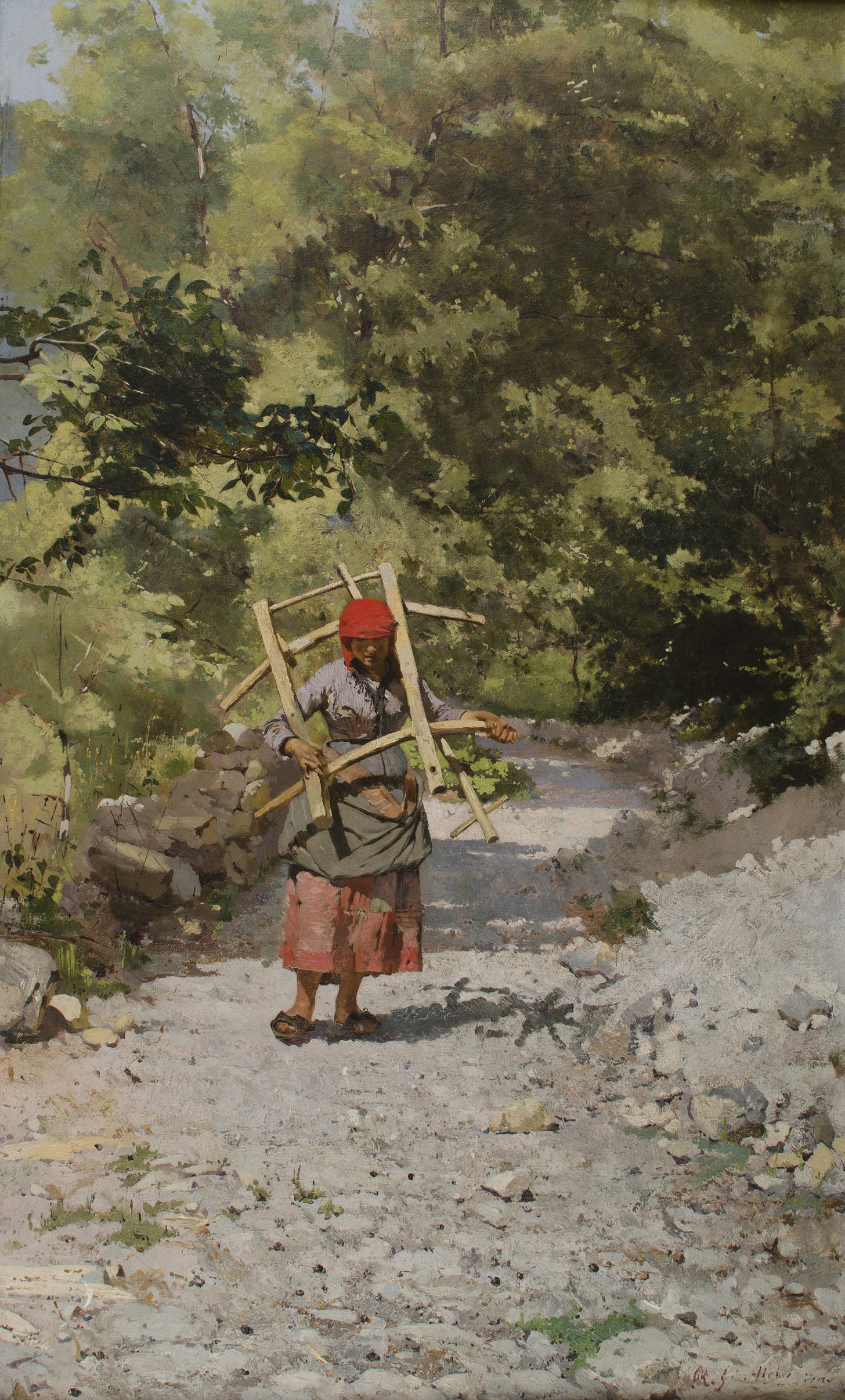Studying Everything, Just Around the Corner
Reading Hebe Uhart, "A Question of Belonging," Session 1

I’ve been pretty busy the last few weeks and even missed my usual “Letter From London” altogether last weekend. I’m hoping to get another Letter posted here soon. Today, though, we have something different planned, as I announced last week: we begin the first From My Bookshelf read-along!
We’re reading A Question of Belonging, a collection of stories (although, as we’ll see, that is not exactly the right word) by Argentinian writer Hebe Uhart, translated by Anna Vilner and published by Archipelago Books. I am reading this together with students for a class I teach called “Around the World: Reading Across Borders,” which looks at world literature in English translation. I’m a political theorist, so this is not my specialty, only a chance to broaden my own horizons. On Friday my students discussed the first 83 pages of the book (14 stories). I’ll share some thoughts on these, and I invite you to respond in the comments or add observations and reactions of your own. (And if you haven’t been reading along so far… there’s still time! Next week we’ll be reading another 5 stories, pages 84-166.)
Off we go!
What are we reading in A Question of Belonging? I referred to it earlier as a collection of stories, and while that’s not an unfair description, it is also slightly misleading. The pieces collected in this volume are short, and they have the feel of first-person stories. But they aren’t simply fictional. They draw upon Uhart’s experiences, travel, and encounters with people she meets. But they are also not memoirs or autobiography. They don’t aim at telling the story of Uhart’s life, nor do they present a thorough or detailed account of the places she visits.
The book’s front cover announces, beneath the title, that these are “Crónicas by Hebe Uhart.” The crónica is evidently a common genre in Latin American literature and Uhart an important recent practitioner of it. Crónicas blend journalism with fiction, offering snapshots of real people and their lives, but presented as narrative rather than as history or reporting. According to that modern-day oracle, Wikipedia, the crónica “crosses the boundaries between fiction and non-fiction, a gray area between literature and journalism.”
Knowing that we are encountering real people subtly influences our response to these stories, which become a kind of moral test for the reader. Perhaps all fiction is actually a kind of test, with our reactions to a story offering a moral barometer measuring our character. But we become more conscious of this when we know we are responding to and evaluating actual human beings rather than fictional creations. If we respond to them inappropriately, we are guilty not simply of poor reading or misinterpretation; rather, we are committing something like an injustice against a specific person.
The reluctance to commit such an injustice is heightened by two aspects of A Question of Belonging. First, the people to whom Uhart introduces us are so very, very ordinary. One of my students described her as a “historian of ordinary people,” which I thought was an apt characterization. These are not political leaders, business titans, or cultural icons, people who by virtue of their prominence have put their lives on display, practically inviting our judgement upon them. The characters peopling Uhart’s pages are typically simple, of modest means, perhaps uneducated, living off the beaten path. They never asked for our opinion about their lives.
Second, Uhart treats her own characters with great respect. She is forgiving toward their weaknesses and tolerant of their eccentricities. She maintains a neutral tone, slipping only occasionally into admiration or critique. Rushing to criticize these people in the face of Uhart’s restraint and her careful withholding of judgement would feel presumptuous. She writes at one point that “nobody cares about offending others these days, nobody cares much about anyone” (page 25). But Uhart herself seems to care a great deal. And because she wishes not to give offense, we readers care also.

A couple of sentences in this first third of the book stand out as especially indicative of Uhart’s approach. When she wakes up early in a new place, before everyone else, she can “take [her] time and look at everything going on outside. More than look, I study everything” (51). That she does. Uhart is a close observer. And she likes to observe the things that others overlook. When a pair of tourists tell her that they’re planning an outing that will require a trip by plane, she thinks, “I didn’t have the money or the desire to board a plane that would take me far away, and I thought: ‘Everyone’s going so far away, on such long excursions. I should go somewhere too, but just around the corner’” (79). As another of my students said, Uhart likes to travel, but she does not go to the “big,” famous, popular destinations. She prefers the less-traveled road.
Uhart can compress the outline of a novel into a couple of paragraphs, quickly sketching a very ordinary life in a way that hints at dramatic possibilities embedded within it. We meet a man named Raúl, who offers a condensed version of his life story:
“This whole area was dairy farms when I was a kid. My dad was a railroad worker and when it rained, he wasn’t able to go back to town, so he would stay in Lobos. I was a railroad worker too, till the electricity came. Personally, I liked the steam engine, I would toss wood inside of it. See that photo? That’s my dad with the station manager, he was very no-nonsense, an Englishman, he had some cows near the tracks and my dad used to milk them. When there was fog, they’d set off firecrackers as a warning and Dad would give us some to play with. My school was made entirely of wood, a shame they tore it down. Do you see those mosaics over there on the floor? They belonged to the school.” The mosaics are perfectly matched to another area; so well, it seems the floor has always been that way. “We used to have fun at the barn dances—countrymen from the interior would come and dance the ranchera, polka, and a bit of pericón. When they left the dance, they’d go straight to work at the dairy farm. I built this house and both of my sons’ houses, too. These ones.” (48-49)
Two paragraphs later, we also learn that Raúl—now 85 years old and doing various odd jobs to make ends meet—got divorced 37 years earlier and has raised five children on his own. Raúl may seem outwardly unimpressive, but in a page and a half we discover that his life contains the raw material for a Familienroman spanning three generations and more than a century, in a town that has seen immigration from various places (not just the English manager, but also that polka!), the coming of the railroad and eletricity, and the decline of the dairy industry. There is a lot of history packed into this very “ordinary” life.
Raúl is hardly the only memorable character to emerge from these pages. There is Father Werner, for instance (pages 8-11), a priest who had escaped Nazi Germany in disguise, has been removed from his parish for unorthodox practices, carries a “sort of pendulum” to measure people’s “positive energy,” and is riding a train with an odd assortment of baskets and boxes, with which he vanishes as soon as they cross the border (was he smuggling something, one wonders?). Or María Celia the calique (a local political official), whose father narrowly escaped beheading by the colonial authorities. María (pages 58-61, 63-64) now represents her clan as a spokeswoman for indigenous peoples and will not accept the leftovers from a barbecue lest she appear to be seeking special favors for herself rather than the good of her community.

It is noteworthy that Uhart treats both of these characters—the strange, heterodox priest and the conscientious local activist—with comparable respect. One gets the impression that she just plain likes people, and not only likes them, but also finds them interesting. One of the most charming examples (and another to whom we devoted some discussion in class) is Fabricio (pages 65-69). This young man appears first as a likable drifter, a hippie without the drugs. He can’t be bothered to change shirts because he needs to “keep his clothes under control,” and changing outfits takes time he would rather spend “moving from one place to another.” He gathers wood and transports it downstream, confident that “someone is always there” to collect it at the other end. He believes in traveling light, taking “only the essentials in clothing, without money, or luggage, practically without a body.” He refuses to tie himself down to any one place or residence lest it become an “anchor,” weighing him down; instead, he prefers “to collapse distance.” He would rather tear a house down than do some modest remodeling, because the latter is “anti-revolutionary”: “Why repair things just so everything can stay the same?” He rails against powerful banks, which are “narrow-minded” and opposed to progress.
That’s a pretty convincing character sketch of someone determined to live a carefree existence on the margins of society, unencumbered by its expectations. But Uhart knows that people are full of surprises and frequently inconsistent. She suddenly reveals this utterly unexpected, even contradictory fact about Fabricio: he has been applying to English universities, because if he went to study in England he could “establish a routine, because the English all have tea and scones at five in the afternoon, unlike here, where everyone does what they want.” So this gentle anarchist, who refuses to be tied down and is suspicious of property, harbors a secret longing for daily tea and scones at five in the afternoon. When we last hear from Fabricio he is sending spam-like e-mails seeking financial support for a strange business venture “building tools from discarded steel found on the highway.”
It is tempting to highlight other characters and other stories, but that could easily run on for far too long. There are some more themes I hope to take up in the next two sessions, especially the hints of a political stance that peek through some of the stories. But for now I will turn things over to you readers, especially if you’ve been reading the book with me yourself:
How would you describe Uhart’s tone and her stance toward the world?
Were there particular stories, characters, or topics that caught your attention?
What makes the crónica effective as a literary form (if you think that it is)?
Feel free to comment on these questions, my preceding observations, or anything else that caught your fancy.
Remember that next week we’ll consider pages 84-166.
Thanks for reading, and I’ll see you next time for another installment From My Bookshelf.


Hi Peter.
I'm pleased to know that I'll be able to pick up on the reading of this breaking series of posts, which will not be as they are posted but at some point beyond the posting of the last one.
I did check out the book, online, and was able to access a sample. Which was enticing but limited to the Introduction, so that I have not directly sampled Hebe Uhart's pieces.
While they are short pieces of writing I'm not too keen on reading them 'en bloc' but rather my preference would be to take one at a time, read it, re-read, let it settle and so savour - slowly - what it says and where it may take my imagination.
Your purposes in reading at some pace make absolute sense for you and your participating students.
So thanks for opening the door to this collection from this new-to-me writer. Thanks to the way you've set up and are operating your Substack I'll be able to offer any comment that I may wish to some ways down the reading road ahead.
Rob